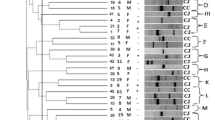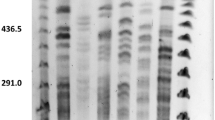Abstract
The natural occurrence of plasmids in “Campylobacter upsaliensis” (catalase negative or weak campylobacters: CNW group) was investigated. The 62 strains isolated from patients with gastroenteritis or bacteraemia in five countries (South Africa, Belgium, Sweden, UK and Australia) were screened for plasmid DNA, which was detected in 54 (87%) of them. Plasmids were of various sizes between 1.4 and 90-Md and up to three or possibly four plasmids were present in 26 (42%) strains. A total of 15 different plasmid profile types were identified. Strains of profile type 2, containing 2.8-, 34- and 60-Md plasmids and a less distinct 5-Md plasmid, were the most frequently encountered (22 strains) and they exhibited a wide geograhical distribution. Overall the 34- and 2.8-Md plasmids were the commonest occurring in 58 and 55% of plasmid containing strains respectively. Nine strains from dog faeces were also examined and some had identical profiles to human isolates, suggesting a possible animal to man transmission route. These findings show that plasmid profiling has considerable potential as a typing method for “C. upsaliensis”.
Similar content being viewed by others
References
Bradbury W.C., Marko M.A., Hennessy J.N. and Penner J.L. (1983): Occurrence of plasmid DNA in serologically defined strains of Campylobacter jejuni and Campylobacter coli. - Infect. Immun. 40: 460–463.
Bradbury W.C., Pearson A.D., Marko M.A., Congi R.V. and Penner J.L. (1984): Investigation of a Campylobacter jejuni outbreak by serotyping and chromosomal restriction endonuclease analysis. - J. Clin. Microbiol. 19: 342–346.
Bradbury W.C. and Munroe D.L.G. (1985): Occurrence of plasmids and antibiotic resistance among Campylobacter jejuni and Campylobacter coli isolated from healthy and diarrhoeic animals. - J. Clin. Microbiol. 22: 339–346.
Goossens H., De Boeck M., Coignam H., Vlaes L., Van Den Barre C. and Butzler J.P. (1986): Modified selective medium for isolation of Campylobacter spp. from faeces: a comparison with Preston medium; a blood-free medium, and a filtration system. - J. Clin. Microbiol. 24: 840–843.
Goossens H., Pot B., Vlaes L., et al. (1990): Characterization and description of “Campylobacter upsaliensis” isolated from human faeces. - J. Clin. Microbiol. In press.
Kado C.I. and Liu S.T. (1981): Rapid procedure for detection and isolation of large and small plasmids. -J. Bacteriol. 145: 1365–1373.
Kaijser B. (1988): Campylobacter jejuni/coli. - Acta. pathol. microbiol. immunol. scand. Sect. B 96: 283–288.
Kakoyiannis C.K., Winter P.J. and Marshall R.B. (1988): The relationship between intestinal Campylobacter species isolated from animals and humans as determined by BRENDA. - Epidem. Inf. 100: 379–387.
Lastovica A.J. and Ambrosio R.E. (1986): Plasmid profiles of clinical isolates of Campylobacter with no or weak catalase activity. - South African Med. J. 70: 337–338.
Lastovica A.J., Le Roux E. and Penner J.L. (1989): “Campylobacter upsaliensis” isolated from blood cultures of paediatric patients. - J. Clin. Microbiol. 27: 657–659.
MayerL. W. (1988): Use of plasmid profiles in epidemiologic surveillance of disease outbreaks and tracing the transmission of antibiotic resistance. -Clin. Microbiol. Rev. 1: 228–243.
MegraudF. and BonnetF. (1986): Unusual campylobacters in human faeces. - J. Infect. 12: 275–276.
OwenR.J., CostasM. and SlossL.L. (1988): Electrophoretic protein typing of Campylobacter jejuni subspecies “doylei” (nitrate-negative campylobacter-like organisms) from human faeces and gastric mucosa. - Euro J. Epidemiol. 4: 277–283.
PattonC.M., ShafferN., EdmondsP., BarrettT.J., LambertM.A., BakerC., PerlmanD.M. and BrennerD.J. (1989): Human disease associated with “Campylobacter upsaliensis” (catalase-negative of weakly positive Campylobacter species) in the United States. - J. Clin. Microbiol. 27: 66–73.
SandstedtK., UrsingJ. and WalderM. (1983): Thermotolerant Campylobacter with no or weak catalase activity isolated from dogs. - Curr. Microbiol. 8: 209–213.
SandstedtK. and UrsingJ. (1986): Campylobacter upsaliensis, a new species, formerly the CNW group.- Abst. XIV Int. Cong. Microbiol. Manchester, IUMS. pp. 61.
SkirrowM.B. (1987): A demographic survey of campylobacter, salmonella and shigella infections in England. A Public Health Laboratory Service Survey. - Epidem. Inf. 49: 647–657.
SteeleT. W., SangsterN. and LanserJ.A. (1985): DNA relatedness and biochemical features of Campylobacter spp. isolated in Central and South Australia. - J. Clin. Microbiol. 22: 71–74.
TeeW., AndersonB.N., RossB. C. and DwyerB. (1987): Atypical campylobacters associated with gastroenteritis. - J. Clin. Microbiol. 25: 1248–1252.
Author information
Authors and Affiliations
Rights and permissions
About this article
Cite this article
Owen, R.J., Hernandez, J. Occurrence of plasmids in “Campylobacter upsaliensis” (catalase negative or weak group) from geographically diverse patients with gastroenteritis or bacteraemia. Eur J Epidemiol 6, 111–117 (1990). https://doi.org/10.1007/BF00145782
Issue Date:
DOI: https://doi.org/10.1007/BF00145782




